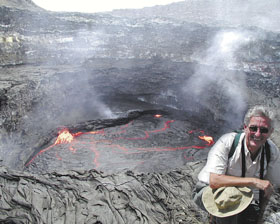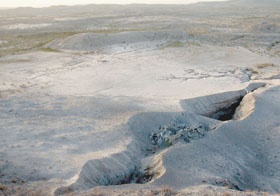  |
| HOME | THIS ISSUE | CALENDAR | GRANTS | BACK ISSUES | < BACK | NEXT > |
Geologist joins expedition to study new volcano in Ethiopiaby Sherry Fisher - November 28, 2005 |
||||||
|
Crouched at the edge of one of the earth’s most active volcanoes posing for television crews, Tony Philpotts asked the journalists to hurry.
“It was unbelievably hot,” says Philpotts, professor emeritus of geology and geophysics. Boiling lava brewed behind him, burning his back. Philpotts was in the remote Afar region of Ethiopia beside Erta’ale, a basaltic shield volcano that has had an active lava lake in its summit for more than 100 years. While seeing Erta’ale was “incredible,” Philpotts says, the main reason for the trip was even more compelling: to study a new volcano, called Da’Ure, 80 miles to the southwest Erta’ale, that formed on Sept. 26. The journey began one evening in early October, when Philpotts received an e-mail from Araya Asfaw, dean of the Faculty of Science at Addis Ababa University in Ethiopia saying a new volcano had just erupted, and asking him to come immediately. “So I had my yellow fever shots and malaria pills the next day, and six days later I was gone,” Philpotts says. The University of Connecticut has recently signed an agreement with Addis Ababa University to develop cooperative programs. Philpotts was told that on Sept. 20, earthquakes were recorded at the Geophysical Observatory of Addis Ababa University with epicenters in the Afar region. “During a five-day period, 131 earthquakes were reported from a small area in the Afar,” he says. “At that point, geophysicists realized that the earthquakes were a portent to a volcanic eruption. They notified the region’s governor, who quickly evacuated some 50,000 nomads – and their camels and goats. This was a difficult task.” A team from Addis Ababa University went to the area where the earthquakes were occurring. They witnessed a large number of fractures and faults. Two hours after they left the area, the new volcano exploded. “If they hadn’t left when they did, they would have been killed by the eruption,” says Philpotts, whose expedition arrived two weeks later. His group included scientists from Cambridge, London, Naples, and Addis Ababa University, along with television journalists and armed guards supplied by the governor of Afar. They traveled for four days by military helicopter, visiting the Erta’ale volcano and the newly formed volcano. The trip offered amazing views of the region, he says. Philpotts snapped hundreds of photographs of dormant and active volcanoes, cracks in the earth’s surface, and flat land peppered with nomadic dwellings. Afar is “remote, inhospitable, and inaccessible,” he says. “It’s an incredibly desolate area, with virtually nothing growing, but these nomads manage to live there. Not only is the natural environment challenging, the political climate is unsettled, says Philpotts. “The nomads are heavily armed and that is why we had armed guards,” he says. The group spent four days traveling to the site, but were able to spend only two hours exploring the new volcano. “The highest temperatures on earth have been recorded here,” Philpotts says, “with typical daytime temperatures rising to 118 degrees Fahrenheit. Any more time spent there would have caused heat exhaustion.”
According to Philpotts, the eruption of the new volcano left a fissure up to 100 yards deep, 500 yards long, and 60 yards wide. He recorded temperatures of up to 750 F in cracks in the pumice dome in the center of the long fissure from which the volcanic ash had previously erupted. Philpotts and his team met with the president of Afar to tell him what they had learned, and to advise him whether to let the nomads return to the area. They also met with other officials and worked closely with Dean Asfaw at Addis Ababa University, who organized the expedition. “The quick coordination between the government of Ethiopia and the University saved many lives,” Philpotts says. During the next few months, the area will be monitored for earthquake activity, which will indicate whether further volcanic activity is likely. Meanwhile, Philpotts is studying the rocks he retrieved from the new volcano, as well as rocks from Erta’ale. Philpotts says the experience was a once-in-a-lifetime opportunity. “I’ve studied active volcanoes in many places during my career,” he says. “But it’s not every day, that I get to see and study a brand new one.” |
| ADVANCE HOME UCONN HOME |


